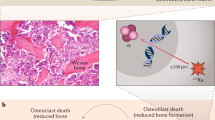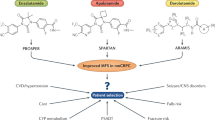Abstract
Prostate cancer is known to have a tissue tropism for bone. This tissue tropism coupled with the experience with androgen deprivation therapy (ADT) over the past decade has led to heightened awareness of bone complications. Osteopenia and subsequent skeletal-related events (SREs) are one of the more concerning repercussions of ADT along with cardiovascular sequelae. To combat this decrease in bone mineral density, several agents have been developed for bone protection. The largest experience is with bisphosphonates (BPs), but recently (2011) head to head trials have established the role of monoclonal antibodies, particularly in patients with prostate cancer bone metastasis. For patients initiating ADT, monthly denosumab increased bone mineral density, the time for occurrence of any bone metastasis and time for symptomatic bone metastasis. Denosumab is a fully human monoclonal antibody of the IgG2 subtype that selectively binds and neutralizes receptor activator NF kappa B ligand (RANKL), inhibiting osteoclastogenesis and bone turnover. In vitro binding assays have shown high-affinity binding of denosumab and osteoprotegerin to both soluble and membrane-bound forms of human RANKL. As clinicians may be less familiar with this newer agent, we compiled this review to summarize denosumab's current clinical indications for bone stabilization and mechanism of reduction in tumor burden.
This is a preview of subscription content, access via your institution
Access options
Subscribe to this journal
Receive 4 print issues and online access
$259.00 per year
only $64.75 per issue
Buy this article
- Purchase on Springer Link
- Instant access to full article PDF
Prices may be subject to local taxes which are calculated during checkout

Similar content being viewed by others
References
Shahinian VB, Kuo YF, Freeman JL, Goodwin JS . Risk of fracture after androgen deprivation for prostate cancer. N Engl J Med 2005; 352: 154–164.
Krupski TL, Smith MR, Lee WC, Pashos CL, Brandman J, Wang Q et al. Natural history of bone complications in men with prostate carcinoma initiating androgen deprivation therapy. Cancer 2004; 101: 541–549.
Fizazi K, Carducci M, Smith M, Damião R, Brown J, Karsh L et al. Denosumab versus zoledronic acid for treatment of bone metastases in men with castration-resistant prostate cancer: a randomized, double-blind study. Lancet 2011; 377: 813–822.
Smith MR, Egerdie B, Hernandez TN, Feldman R, Tammela TL et al. Denosumab in men receiving androgen-deprivation therapy for prostate cancer. N Engl J Med 2009; 361: 745–755.
Tabrizi MA, Tseng CM, Roskos LK . Elimination mechanisms of therapeutic monoclonal antibodies. Drug Discov Today 2006; 11: 81–88.
Smith MR, Saad F, Coleman R, Shore N, Fizazi K, Tombal B et al. Denosumab and bone-metastasis-free survival in men with castration-resistant prostate cancer: results of a phase 3, randomised, placebo-controlled trial. Lancet 2012; 379: 39–46.
Lacey DL, Timms E, Tan HL, Kelley MJ, Dunstan CR, Burgess T et al. Osteoprotegerin ligand is a cytokine that regulates osteoclast differentiation and activation. Cell 1998; 98: 165–176.
Kong YY, Feige U, Sarosi I, Bolon B, Tafuri A, Morony S et al. Activated T cells regulate bone loss and joint destruction in adjuvant arthritis through osteoprotegerin ligand. Nature 1999; 402: 304–309.
Simonet WS, Lacey DL, Dunstan CR, Kelley M, Chang MS, Luthy R et al. Osteogrotegerin: a novel secreted protein involved in the regulation of bone density. Cell 1997; 89: 309–319.
Roodman GD . Mechanisms of bone metastasis. N Engl J Med 2004; 350: 1655–1664.
Morony S, Capparelli C, Sarosi I, Lacey DL, Dunstan CR, Kostenuik PJ . Osteoprotegerin inhibits osteolysis and decreases skeletal tumor burden in syngeneic and nude mouse models of experimental bone metastasis. Cancer Res 2001; 61: 4432–4436.
Morony S, Capparelli C, Kostenuik PJ, Rattan A, Scully S, Tarpley J et al. Osteoprotegerin prevents bone destructionin athymic and syngeneic models of experimental tumor metastasis to bone. Cancer 2000; 88: 3107.
Stopeck A, Martin M, Ritchie D et al. Effect of denosumab versus zoledronic acid treatment in patients with breast cancer and bone metastases: results from the extended blinded treatment phase. Paper presented at: 33rd Annual CTRC AACR San Antonio Breast Cancer Symposium, 8 December 2010 to 12 December 2010; San Antonio, TX. Abstract P6-14-01.
Henry DH, Costa L, Goldwasser F, Hirsh V, Hungria V, Prausova J et al. Randomized, double-blind study of denosumab versus zoledronic acid in the treatment of bone metastases in patients with advanced cancer (excluding breast and prostate cancer) or multiple myeloma. J Clin Oncol 2011; 29: 1125–1132.
Body JJ, Facon T, Coleman RE, Lipton A, Geurs F, Fan M et al. A study of the biological receptor activator of nuclear factor-kappaB ligand inhibitor, denosumab, in patients with multiple myeloma or bone metastases from breast cancer. Clin Cancer Res 2006; 12: 1221–1228.
Fiazi K, Lipton A, Mariette X, Body JJ, Rahim Y, Gralow JR et al. Randomized phase II trial of denosumab in patients with bone metastases from prostate cancer, breast cancer, or other neoplasms after intravenous bisphosphonates. J Clin Oncol 2009; 27: 1564–1571.
Lipton A, Steger GG, Figueroa J, Alvarado C, Solal-Celigny P, Body JJ et al. Randomized active-controlled phase II study of denosumab efficacy and safety in patients with breast cancer-related bone metastases. J Clin Oncol 2007; 25: 4431–4437.
Armstrong AP, Miller RE, Jones JC, Zhang J, Keller ET, Dougall WC . RANKL acts directly on RANK-expressing prostate tumor cells and mediates migration and expression of tumor metastasis genes. Prostate 2008; 68: 92–104.
Jones DH, Nakashima T, Sanchez OH, Kozieradzki I, Komarova SV, Sarosi I et al. Regulation of cancer cell migration and bone metastasis by RANKL. Nature 2006; 440: 692–696.
Chen G, Sircar K, Apirkian A, Potti A, Goltzman D, Rabbani SA . Expression of RANKL/RANK/OPG in primary and metastatic human prostate cancer as markers of disease stage and functional regulation. Cancer 2006; 107: 289–298.
Jung K, Stephan C, Semjonow A, Lein M, Schnorr D, Loening SA . Serum osteoprotegerin and receptor activator of nuclear factor-kappa B ligand as indicators of distrubed osteoclastogenesis in patients with prostate cancer. J Urol 2003; 170 (6 Part 1): 2302–2305.
Eaton CL, Wells JM, Holen I, Croucher PI, Hamdy FC . Serum osteoprotegerin (OPG) levels are associated with disease progression and response to androgen ablation in patients with prostate cancer. Prostate 2004; 59: 304–310.
Brown JM, Vessela RL, Kostenuik PJ, Dunstan CR, Lange PH, Corey E . Serum osteoprotegerin levels are increased in patients with advanced prostate cancer. Clin Cancer Res 2001; 7: 2977–2983.
Jung K, Lein M, Stephan C, Von Hosslin K, Semjonow A, Sinha P et al. Comparison of 10 serium bone turnover markers in prostate carcinoma patients with bone metastatic spread: diagnostic and prognostic implications. Int J Cancer 2004; 111: 783–791.
Pierroz DD, Bonnet N, Baldock PA, Ominsky MS, Stolina M, Kostenuik PJ et al. Are osteoclasts needed for the bone anabolic response to parathyroid hormone? A study of intermittent parathyroid hormone with denosumab or alendronate in knock-in mice expressing humanized RANKL. J Biol Chem 2010; 285: 28164–28173.
Canon JR, Roudier M, Bryant R, Morony S, Stolina M, Kostenuik PJ et al. Inhibition of RANKL blocks skeletal tumor progression and improves survival in a mouse model of breast cancer bone metastasis. Clin Exp Metastasis 2008; 25: 119–129.
Virk MS, Alaee F, Petrigliano FA, Sugiyama O, Chatziioannou AF et al. Combined inhibition of the BMP pathway and the RANK/RANKL axis in a mixed lytic/blastic prostate cancer lesion. Bone 2011; 48: 578–587.
Mori K, Le Goff B, Charrier C, Battaglia S, Heymann D, Redini F . DU145 human prostate cancer cells express functional receptor activator of NFkappaB: new insights in the prostate cancer bone metastasis process. Bone 2007; 40: 981–990.
Tometsko M, Armstrong A, Miller R, Jones J, Chaisson M, Branstetter D et al. RANK ligand directly induces osteoclastogenic, angiogenic, chemoattractive and invasive factors on RANK-espressing human cancer cells MDA-MG-231 and PC3. Presented at: The 25th Annual Meeting of the American Soceity for Bone and Mineral Research; 1 October 2004 to 5 october 2004; Seattle, Wash. Abstract 1095.
Thomas RJ, Guise TA, Yin JJ, Elliott J, Horwood NJ, Martin TJ et al. Breast cancer cells interact with osteoblasts to support osteoclast formation. Endocrinology 1999; 140: 4451–4458.
Chaisson ML, Branstetter DG, Derry JM, Armstrong AP, Tometsko ME et al. Osteoclast differentiation is imparied in the absence of inhibitor of kappa B kinase alpha. J Biol Chem 2004; 279: 54841–54848.
Fernandez-Valdivia R, Mukherjee A, Ying Y, Li J, Paquet M, Demayo FJ et al. The RANKL signaling axis is sufficient to elicit ductal side-branching and alveologenesis in the mammary gland of the virgin mouse. Dev Biol 2009; 328: 127–139.
Gonzalez-Suarez E, Jacob AP, Jones J, Miller R, Roudier-Meyer MP, Erwert R et al. RANK ligand mediates progestin-induced mammary epithelial proliferation and carcinogenesis. Nature 2010; 468: 103–107.
Tan W, Zhang W, Strasner A, Grivennikov S, Cheng JQ, Hoffman RM et al. Tumour-infiltrating regulator T cells stimulate mammary cancer metastasis through RANKL-RANK signalling. Nature 2011; 470: 548–553.
Miller RE, Roudier M, Jones J, Armstrong A, Canon J, Dougall WC . RANK ligand inhibition plus docetaxel improves survival and reduces tumor burden in a murine model of prostate cancer bone metastasis. Mol Cancer Ther 2008; 7: 2160–2169.
Boyle WJ, Simonet WS, Lacey DL . Osteoclast differentiation and activation. Nature 2003; 423: 337–342.
Author information
Authors and Affiliations
Corresponding author
Ethics declarations
Competing interests
The author declares no conflict of interest.
Rights and permissions
About this article
Cite this article
Helo, S., Manger, J. & Krupski, T. Role of denosumab in prostate cancer. Prostate Cancer Prostatic Dis 15, 231–236 (2012). https://doi.org/10.1038/pcan.2012.2
Received:
Revised:
Accepted:
Published:
Issue Date:
DOI: https://doi.org/10.1038/pcan.2012.2



